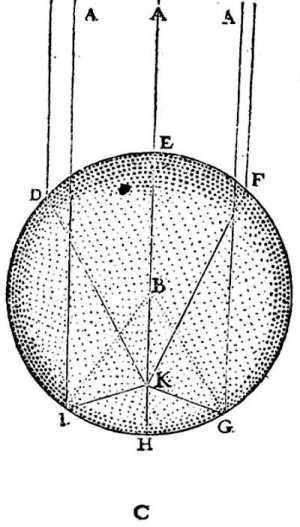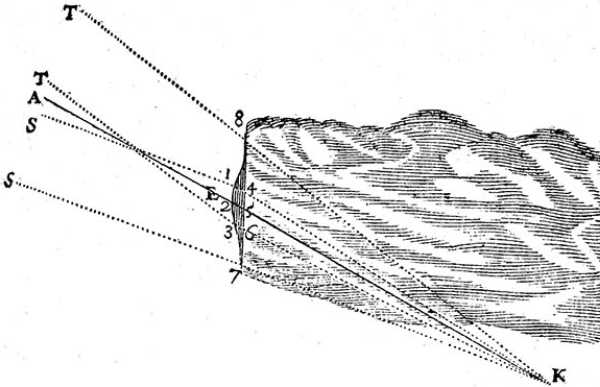How 6 Suns Can Appear in the Sky
Table of Contents
When it is formed, one can see, from below towards point K, up to 6 suns.
- These suns seem embedded in the white circle like so many diamonds in a ring.

-
Towards
E, by the rays coming directly from the sun atA -
Towards
D -
Towards
F
These are by the refraction of the rays that pass through the ice at these points where its thickness decreases
This bends inward on either side, as they do when passing through the crystal prism.
This is why, these 2 suns have their edges painted red on the side towards E, where the ice is thickest, and blue on the other side, where it is thinner.
-
At point H by reflection .
-
Towards
G -
Towards
Ialso by reflection
Draw a circle with its center at point K and passing through B, the cloud’s center.
- In this way, angles
KGBandKBGorBGAand likewiseKIBandKBIorBIAare equal.
Reflection always occurs at equal angles.
Ice, being a polished body, must represent the sun in all places from which its rays can reflect towards the eye.
However, the rays that come straight are always brighter than those refracted.
And so, the sun should appear brighter towards E than towards D or F, and here still brighter than towards G, H, or I.
G, H, and I, should have no colors around their edges like the two D and F, but only be white.
If the viewers are not at K but somewhere more advanced towards B, then the circle whose center is their eyes and passes through B does not cut the circumference of the cloud.
- They will not see the 2 suns
GandI, but only the other 4.
Conversely, if they are far back towards H or beyond towards C, they will see only the five D, E, F, G, and I.
If they are far enough beyond, they will see only the three D, E, F.
- These will no longer be in a white circle but crossed by a white bar.
Likewise, when the sun is so low on the horizon that it cannot illuminate the part of the cloud GHI, or if it is not yet formed, it is evident that only the three suns D, E, F should be seen.
Furthermore, I have only made you consider the plane of this cloud so far, and there are still various things to note that will be better seen in its profile.
The sun is not in the straight line that goes from E to the eye K, but higher or lower, it should still appear in that direction.
Especially if the ice does not extend too much in height or depth.
For then, the surface of this ice will be so curved that wherever the sun is, it will almost always be able to reflect its rays towards K.

As if it has in its thickness the shape enclosed between lines 123 and 456, it is evident that not only when the sun is in the straight line A2, its rays passing through will be able to go towards the eye K;
But also when it is much lower, as in line SI, or much higher, as in line T3; and thus always make it appear as if it were towards E.
For assuming the ice ring is not very wide, the difference between lines 4K, 5K, and 6K is not significant.
Note that this can make the sun appear even after it has set, and it can also delay or advance the shadow of sundials, making them indicate a time different from the actual one.
However, if the sun is much lower than it appears towards E, so that its rays also pass in a straight line below the ice, towards the eye K, like S7K, which I assume is parallel to SI, then besides the previous six suns, a seventh one will be seen below them, and having the most light, it will erase the shadow they could cast on the sundials.
Similarly, if it is so high that its rays can pass in a straight line towards K above the ice, like T8K which is parallel to T3, and the interposed cloud is not so opaque as to block them, a seventh sun can be seen above the other six.
If the ice 123, 456 extends higher and lower to points 8 and 7, the sun being towards A, three can be seen one above the other, towards E, at points 8, 5, and 7.
Then 3 can also be seen one above the other towards D, and 3 towards F, making up to 12 suns appear embedded in the white circle DEFGHI.
If the sun is a little lower than towards S, or higher than towards T, 3 can again appear towards E, namely 2 in the white circle and another below or above.
Two can also appear towards D, and two towards F.
But I do not know of any instance where so many have been observed at once; nor even that when three have been seen one above the other, as has happened several times, any others have been noted beside them.
Or that when three have been seen side by side, as has also happened several times, any others have been noted above or below.
This is because the width of the ice, marked between points 7 and 8, usually has no proportion to the size of the whole cloud’s circumference.
So the eye must be very close to point E for this width to appear large enough to distinguish three suns one above the other.
Conversely, very far away, so that the rays bending towards D and F, where the ice thickness diminishes the most, can reach the eye.